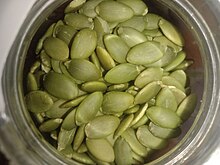Pumpkin seed


A pumpkin seed, also known in North America as a pepita (from the Mexican
Cuisine

Pumpkin seeds are a common ingredient in
The earliest known evidence of the domestication of Cucurbita dates back 8,000–10,000 years ago, predating the domestication of other crops such as maize and common beans in the region by about 4,000 years. Changes in fruit shape and color indicate intentional breeding of C. pepo occurred by no later than 8,000 years ago.[3][4] The process to develop the agricultural knowledge of crop domestication took place over 5,000–6,500 years in Mesoamerica. Squash was domesticated first, with maize second, followed by beans, all becoming part of the Three Sisters agricultural system.[5][6]

As an ingredient in
The pressed oil of the roasted seeds of a Cucurbita pepo subsp. pepo var. 'styriaca' is also used in Central and Eastern Europe cuisine.[9][10] Pumpkin seeds can also be made into a nut butter. Pumpkin seeds can also be steeped in neutral alcohol, which is then distilled to produce an eau de vie.[11]
Nutrition
| Nutritional value per 100 g (3.5 oz) | |
|---|---|
| Energy | 2,401 kJ (574 kcal) |
14.71 g | |
| Sugars | 1.29 g |
| Dietary fiber | 6.5 g |
49.05 g | |
| Saturated | 8.544 g |
| Monounsaturated | 15.734 |
| Polyunsaturated | 19.856 |
29.84 g | |
Niacin (B3) | 28% 4.43 mg |
| Pantothenic acid (B5) | 11% 0.57 mg |
| Vitamin B6 | 6% 0.1 mg |
| Folate (B9) | 14% 57 μg |
| Vitamin C | 7% 6.5 mg |
| Vitamin E | 4% 0.56 mg |
| Vitamin K | 4% 4.5 μg |
| Minerals | Quantity %DV† |
| Calcium | 4% 52 mg |
| Iron | 45% 8.07 mg |
| Magnesium | 131% 550 mg |
| Manganese | 195% 4.49 mg |
| Phosphorus | 94% 1174 mg |
| Potassium | 26% 788 mg |
| Sodium | 11% 256 mg |
| Zinc | 69% 7.64 mg |
| Other constituents | Quantity |
| Water | 2.0 g |
| †Percentages estimated using US recommendations for adults,[12] except for potassium, which is estimated based on expert recommendation from the National Academies.[13] | |
Dried, roasted pumpkin seeds are 2% water, 49%
Oil
Pumpkin seed oil, a culinary specialty in and important export commodity of Central Europe, is used in cuisine as a salad and cooking oil.
The following are ranges of fatty acid content in C. maxima pepitas:[15]
| n:unsat | Fatty acid name | Percentage range |
|---|---|---|
| (14:0) | Myristic acid | 0.003–0.056 |
| (16:0) | Palmitic acid | 1.6–8.0 |
| (16:1) | Palmitoleic acid | 0.02–0.10 |
| (18:0) | Stearic acid | 0.81–3.21 |
| (18:1) | Oleic acid | 3.4–19.4 |
| (18:2) | Linoleic acid | 5.1–20.4 |
| (18:3) | Linolenic acid | 0.06–0.22 |
| (20:0) | Arachidic acid | 0.06–0.21 |
| (20:1) | Gadoleic acid | 0–0.035 |
| (22:0) | Behenic acid | 0.02–0.12 |
The total
Traditional medicine
Pumpkin seeds were once used as an
Market
Due to their versatility as a food product ingredient or snack, pumpkin seeds are projected to grow in sales by 13% annually and reach $631 million from 2020 to 2024.[18]
See also
References
- S2CID 94061331.
- ^ "Pepitas (Pumpkin Seeds)". GourmetSleuth.com. Retrieved 11 February 2013.
- .
- ^ "Cucurbitaceae—Fruits for Peons, Pilgrims, and Pharaohs". University of California at Los Angeles. Archived from the original on October 16, 2013. Retrieved September 2, 2013.
- ^ Landon, Amanda J. (2008). "The "How" of the Three Sisters: The Origins of Agriculture in Mesoamerica and the Human Niche". Nebraska Anthropologist: 110–124.
- .
- ISBN 978-1-941252-22-2.
- ISBN 978-0-553-44730-9.
- S2CID 16454305.
- S2CID 97993637.
- ^ "Beim Schnapsbrenner in Spalt: Destillierte Heimat" [At the Schnaps Maker in Spalt: Distilled Homeland]. Bayerischer Rundfunk (in German). 2 March 2019. Retrieved 21 November 2021.
- ^ United States Food and Drug Administration (2024). "Daily Value on the Nutrition and Supplement Facts Labels". Retrieved 2024-03-28.
- )
- ^ a b "Nutrition Facts, "Seeds, pumpkin and squash seed kernels, roasted, without salt (pepitas)"". Nutritiondata.com; Conde Nast using the USDA National Nutrient Database, version SR-21. 2018. Retrieved 27 April 2019.
- ^ PMID 17439238. The data are found in Tables 1–3 on pp. 4006–4010 of this USDA reference Archived 2011-08-14 at the Wayback Machine.
- S2CID 202730706.
- ISBN 978-90-481-8660-0.
- ^ Oller, Samantha (2021-01-28). "Pumpkin seeds shift beyond seasonal as their functional qualities shine". Food Dive. Industry Dive. Retrieved 2021-02-01.

